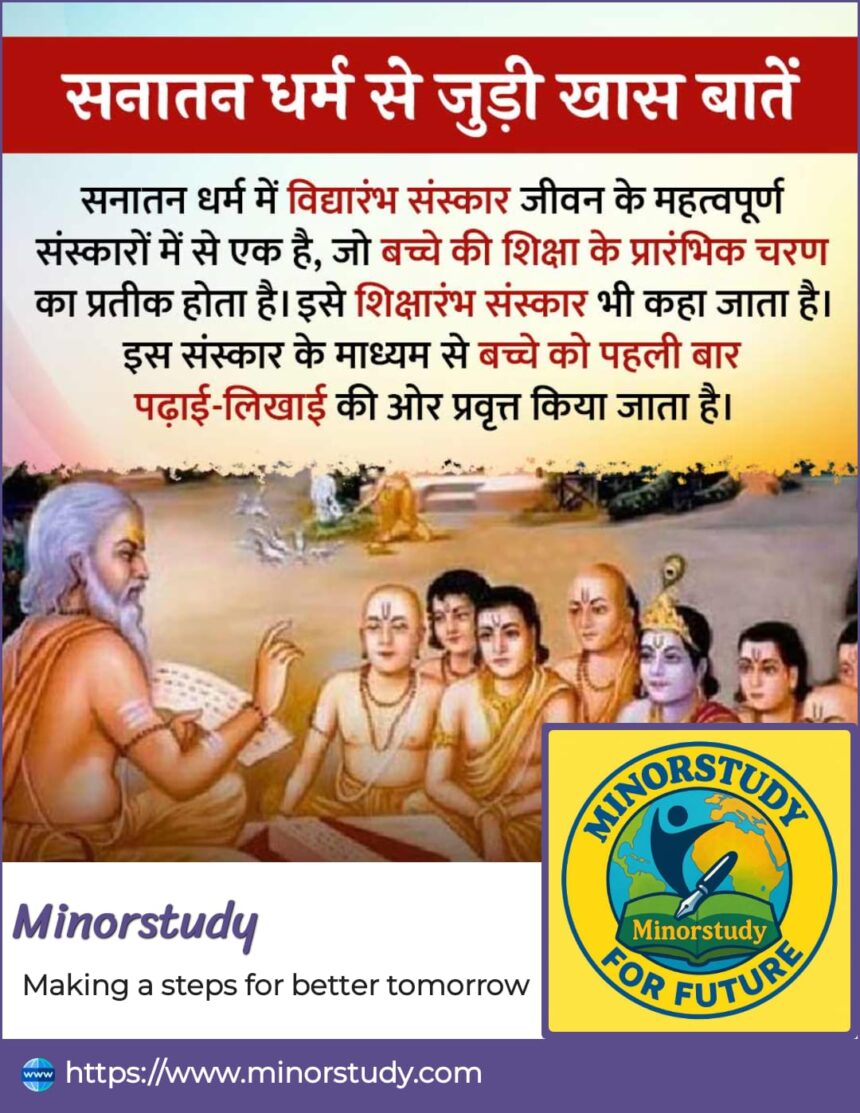🔱 Sacred Truths About Vidyarambh Sanskar That Positively Shape a Child’s Future
Vidyarambh Sanskar: Sanatan Dharma, the eternal and ever-evolving spiritual path, is known for its structured, meaningful journey through life via sixteen samskaras (Shodasha Samskaras). Among these, one holds a particularly transformative and tender place—the Vidyarambh Sanskar or Shiksharambh Sanskar.
- 📜 What Is Vidyarambh Sanskar?
- 🕰️ Timeline & Observance in History
- 🧾 How Is Vidyarambh Sanskar Performed?
- ✨ 9 Powerful Facts About Vidyarambh Sanskar
- 🙋 FAQs About Vidyarambh Sanskar
- Q1. What is the ideal age for Vidyarambh Sanskar?
- Q2. Which deities are worshipped during this ritual?
- Q3. Can this ritual be done at home?
- Q4. Is this different from school admission?
- Q5. Why write on rice or slate?
- 📚 Significance in Sanatan Dharma
- 🎯 Key Points to Remember
- 🌈 Daily Life Impact and Relevance Today
- ✅ Reinforces Value-Based Learning:
- ✅ Enhances Emotional Security:
- ✅ Connects Generations:
- ✅ Promotes Balanced Development:
- 🙏 Wishing & Blessing for Vidyarambh Sanskar
- 🕉️ Conclusion: A Gentle Beginning to a Great Journey
This sacred initiation of education is not just a ritual—it is a spiritual, emotional, and cultural milestone. It symbolizes the lighting of knowledge in the lamp of life, and every Hindu family cherishes it as a moment of divine beginning for their child’s intellectual journey.
This article explores the history, importance, observance, impact, and spiritual significance of the Vidyarambh Sanskar, written in a human-friendly, relatable style. Let’s journey together through its beauty and essence.
📜 What Is Vidyarambh Sanskar?
Vidyarambh = Vidya (Knowledge) + Aarambh (Beginning)
It is the initiation of formal education in a child’s life, observed as a sacred samskara in Sanatan Dharma, often performed when a child is between 2 to 5 years old.
Other Names:
Shiksharambh Sanskar
Aksharabhyasam (in South India)
Haate Khori (in Bengal)
Kalam-Dawaat Chhoona (in North India)
🕰️ Timeline & Observance in History
| Period | Description |
|---|---|
| Vedic Age | Gurukuls initiated students via sacred rituals like Gayatri Mantra Upadesh, sandhya vandan, and Vidyarambh. |
| Epic Period | Lords Ram and Krishna both underwent education initiation rituals with sages and gurus. |
| Medieval Era | Sanskrit pathsalas continued the ritualistic Vidyarambh Sanskar before formal studies. |
| Modern Hindu Families | Still actively observed, especially during auspicious days like Vasant Panchami, Akshaya Tritiya, Vijaya Dashami. |
🧾 How Is Vidyarambh Sanskar Performed?
Common Ritual Practices:
Ganesh & Saraswati Puja for knowledge and wisdom.
Child is made to write first letters—usually “ॐ”, “श्री”, or Gayatri Mantra—on rice, slate, or sand.
Guru or elder guides the child’s hand, symbolizing divine blessing.
A priest or learned person chants mantras like:
“ॐ ऐं सरस्वत्यै नमः” or “ॐ नमः शिवाय”.Gifts like books, pens, and sweets are distributed post-ritual.
✨ 9 Powerful Facts About Vidyarambh Sanskar
Symbolizes Life’s Transition from Innocence to Wisdom
The ritual bridges the playful toddler phase to disciplined learning, embedding curiosity and reverence for education.Rooted in Vedas and Sanatan Beliefs
The Taittiriya Upanishad speaks of knowledge as a means to understand Brahman (the ultimate reality). Vidyarambh initiates this pursuit.Celebrated Across Cultures with Different Names
From Kerala’s ‘Ezhuthiniruthu’ to Bengal’s ‘Haate Khori’, this samskara has universal significance in the Hindu world.Involves Writing with Gold on Rice or Slate
The act of writing first letters on grains or chalkboard symbolizes abundance, nourishment, and purity.Connects Education to Divinity
Goddess Saraswati, the presiding deity of wisdom, is invoked so the child always stays humble, wise, and enlightened.Chosen Auspicious Days Are Spiritually Aligned
Days like Vasant Panchami or Dussehra (Vijaya Dashami) are seen as victorious beginnings, enhancing the success of the child’s learning.Encourages Respect for Teachers and Books
Children are taught to bow before books, touch elders’ feet, and see education as a divine blessing, not just a career tool.Infuses a Sacred Outlook Towards Knowledge
Unlike mechanical learning, this sanskar encourages satvik (pure) intent behind learning—to grow, serve, and uplift society.Builds Emotional Bonding Within Families
Parents, grandparents, teachers, and even community elders take part—making it a shared celebration of hope and future.
🙋 FAQs About Vidyarambh Sanskar
Q1. What is the ideal age for Vidyarambh Sanskar?
A: Between 2.5 to 5 years, as per traditions. Some delay it till school admission at age 6.
Q2. Which deities are worshipped during this ritual?
A: Lord Ganesha and Maa Saraswati are primary. Sometimes Guru Brihaspati is also invoked.
Q3. Can this ritual be done at home?
A: Yes, it can be performed at home with a learned priest or even by parents following simple puja vidhi.
Q4. Is this different from school admission?
A: Yes. Vidyarambh is spiritual and symbolic, not linked to institutional admission, though the timing may overlap.
Q5. Why write on rice or slate?
A: Rice symbolizes prosperity, and writing on it is considered pure and nurturing for the child’s intellect.
📚 Significance in Sanatan Dharma
🌼 Spiritual Foundation of Education:
In Sanatan Dharma, education is not just skill-building but a sacred path to self-realization, making this samskara an entry into spiritual awareness.
📖 Teaching Dharma Through Learning:
The ritual initiates the child into the value of dharma, discipline, truth, and higher knowledge, sowing the seeds for ethical and meaningful living.
🧘 Yoga of Wisdom:
According to Jnana Yoga, true liberation lies in wisdom. Vidyarambh is the first step on this lifelong path.
🎯 Key Points to Remember
Part of 16 Vedic Samskaras that shape holistic life.
Initiates child into formal education with spiritual rituals.
Held on auspicious tithis and performed with mantras and puja.
Encourages gratitude toward books, gurus, and knowledge.
Still widely followed in modern Hindu families across India.
🌈 Daily Life Impact and Relevance Today
✅ Reinforces Value-Based Learning:
In an age of digital distractions, this ritual anchors education in values, focus, and reverence.
✅ Enhances Emotional Security:
A child undergoing this ritual feels blessed, celebrated, and supported—increasing confidence as they start school life.
✅ Connects Generations:
This sanskar brings grandparents, parents, and children together, strengthening cultural continuity.
✅ Promotes Balanced Development:
With focus on mental, emotional, and spiritual well-being, it fosters well-rounded individuals.
🙏 Wishing & Blessing for Vidyarambh Sanskar
✨ “May the lamp of knowledge always shine bright in your child’s life.”
🌸 “May Maa Saraswati bless your little one with wisdom, creativity, and clarity.”
📖 “Happy Vidyarambh! May this divine beginning lead to a journey of excellence and service.”
🧡 “With each letter your child writes, may dharma and knowledge grow stronger.”
🕉️ Conclusion: A Gentle Beginning to a Great Journey
Vidyarambh Sanskar is not merely a rite of passage—it is a soulful blessing for a lifetime of growth. In the hustle of modern education, we often forget the beauty of beginnings.
This samskara teaches that knowledge is not just to earn a livelihood, but to live meaningfully. It is a divine gift that, when nurtured in love, culture, and respect, becomes the guiding light of an entire life.
Let us continue to uphold and celebrate such rituals, for they nurture roots, protect values, and inspire brilliance.
🕊️ Vidyarambh is the first step toward making the child not just literate, but truly wise.








